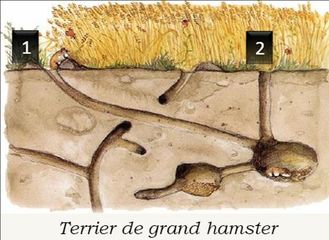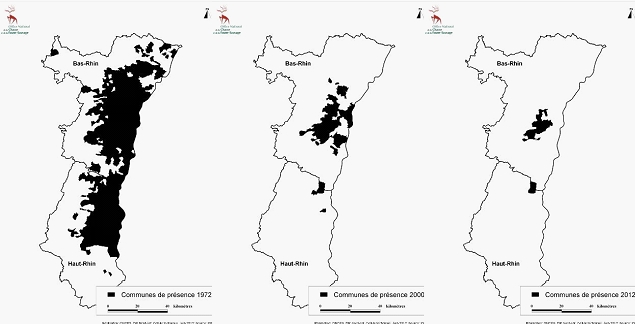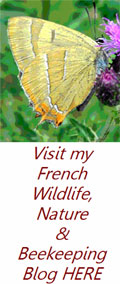Common or Black-bellied Hamster
Cricetus cricetus
Grand Hamster d’Alsace
The Common Hamster has brown dorsal fur with white patches. The chest and belly are black and the tail is short and furred. They are much larger than the Syrian or dwarf hamsters, which are the type commonly kept as pets. They weigh 220-460 g (8-16 ounces) and can grow to 20–35 cm (8-14 inches) long with a tail of 40–60 mm (1.5-2.3 in).
They are a nocturnal or crepuscular species with an original habitat that was comprised of fertile steppe and grasslands, but they have successfully spread into a variety of anthropogenic habitats including meadows, croplands (especially cereals), field edges, road verges and scrubby fallow areas on farms. In eastern parts of their range they are quite often found in gardens and orchards in close proximity to human habitation where they are often more abundant than they are in natural grassland. They prefer a relatively deep, heavy soil in which they dig extensive burrows. Their diet mainly consists of the green parts of plants and seeds, supplemented by invertebrates and occasionally small vertebrates and at high densities they can be an agricultural pest eating grains and root crops.
They transport food in their elastic cheek pouches to the food storage chambers which may be quite large. This is of great importance for them during their hibernation period from October until March when they will wake every 5 to 7 days to feed.
The adults reach sexual maturity when they are about 43 days old and breed from early April to August. The gestation period is 18–20 days and the size of the litter ranges from 3 to 15 young, which are weaned when aged three weeks. They are usually solitary animals with a large global range that extends from western Europe, through central and eastern Europe, Russia, and Kazakhstan, reaching as far east as the Yenisey river (Asian Russia). In Europe, they occur from Belgium, the Netherlands and northern France in the west to Russia in the east and from northern Germany, Poland and Russia in the north to Bulgaria in the south. They are found from sea level to 650 m.
They are a species that has undergone severe range and population declines in western and central Europe, and they now have a highly fragmented distribution in these areas with sub-population extinctions having occurred in a number of countries including Belgium, the Netherlands, France and Germany. Less is known about the status of the species in Eastern Europe and Russia, but it is certainly more abundant there than in the west.
Their decline in Western Europe has been attributed to a combination of persecution and agricultural intensification. They were trapped and poisoned to prevent damage to crops, and this practice continues in some parts of the hamster's range (although not legally in the western part of its range). In Eastern Europe it continues to be trapped for the fur trade. Agricultural intensification, specifically the loss of perennial crops and small uncultivated patches of land, the introduction of autumn-sown cereals, and the increased use of pesticides has had a negative impact on many hamster populations. Changing agricultural practices in Eastern Europe, where the hamster population has traditionally been considered stable, may pose a threat in the future.




